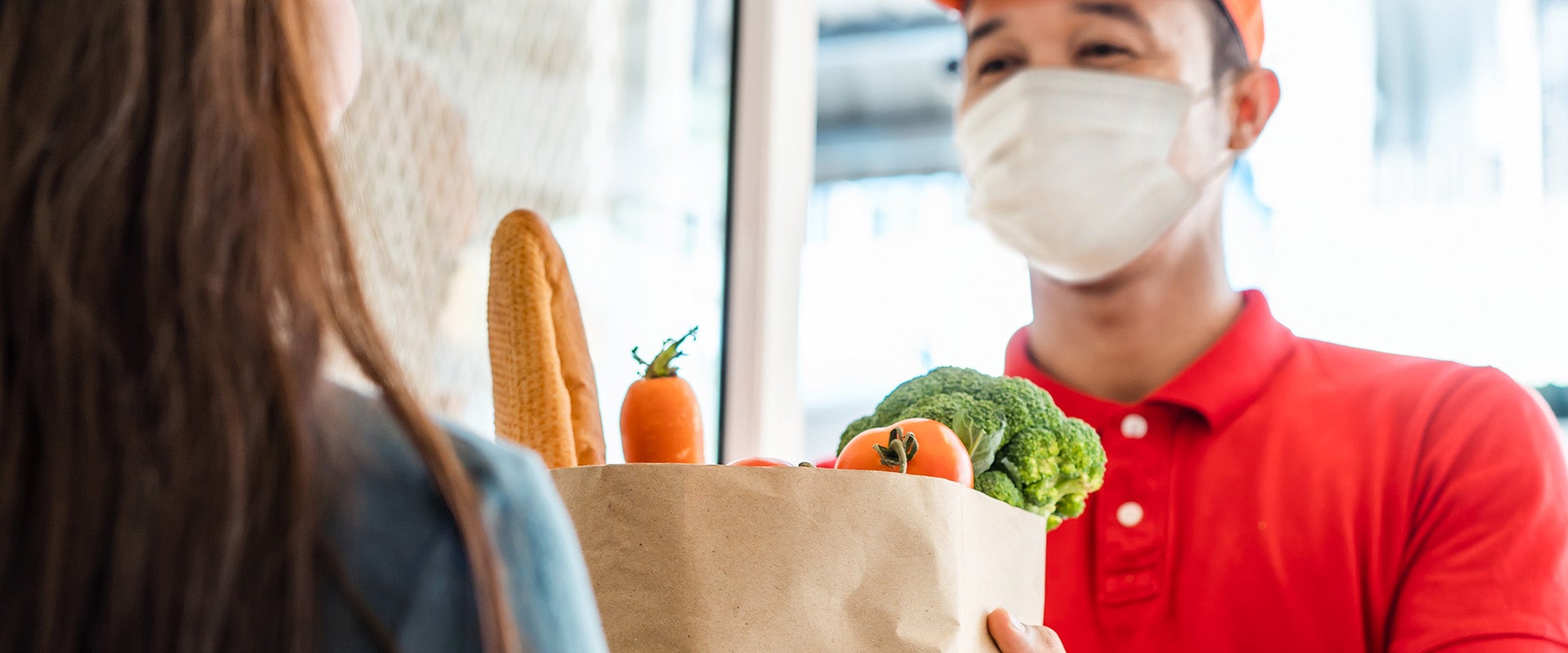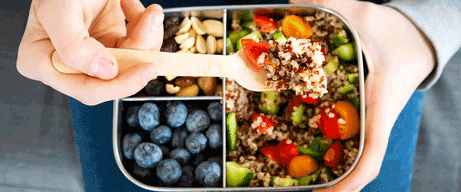
Micro-Fulfillment Centers for Grocery: How Thinking Small Can Be a Big Win
- Volume XXII, Issue 69
- Executive Insights

Due to the pandemic, U.S. consumers across all age groups are driving a rapid acceleration of ecommerce grocery sales.
While not all grocers were ready for this shift, they need a strong ecommerce strategy going forward.
Part of that strategy includes micro-fulfillment centers, which allow retailers to leverage existing stores in order to increase fulfillment efficiency and enable same-day delivery.
The key benefits of micro-fulfillment centers are their small footprint and automation ― meeting demand for pickup in as little as an hour without a significant distribution center investment.
In 2019, ecommerce was estimated to be ~3%-4% of total grocery retail sales, and that share has been growing quickly.1 Even before COVID-19, ecommerce grocery sales had been growing at a strong pace of ~15%-20% per year since 2017,2 driven primarily by younger consumers. L.E.K. Consulting found that millennials were twice as likely as baby boomers to purchase groceries online,3 and forecasted ecommerce penetration for food and beverage to reach ~15%-20% by 2025F.
Now, due to the pandemic, ~35% of U.S. households are estimated to have used ecommerce grocery services in the past 30 days (see Figure 1). Without COVID-19, it would have taken three to five years to reach this level of penetration. This acceleration has in particular driven older consumers to try online grocery purchasing (of first-time grocery ecommerce consumers in March 2020, 39% were ages 60+). By 2024F, the percentage of consumers who have ever purchased groceries online could reach ~66%, according to a forecast by Brick Meets Click. While not all grocers were ready for a rapid shift, they need a strong ecommerce strategy going forward.
Brick-and-mortar stores have had to shift rapidly to accommodate the strong growth in online ordering. As consumers increasingly demand same-day delivery, grocers are expected to expand back rooms in order to create more space in stores for online order fulfillment. Grocers are also likely to perform SKU rationalization in order to create a more targeted in-store assortment, maximizing the decreased selling store space as a result of expanded back rooms and broadening online assortment. Growth in demand for curbside pickup is expected to drive retailers to reserve existing parking lot space for pickup customers and add lockers or automated pickup depots that customers can access via drive-thru. For example, Whole Foods has converted in-store cafes to ecommerce staging areas in high-order-volume cities such as Atlanta and Philadelphia. Walmart is testing automated kiosks that serve as vending machines for online grocery orders. And Hy-Vee introduced grocery pickup lockers outside existing stores and at nearby locations (e.g., in local hospital parking lots).
While the top-line growth is encouraging, keeping online grocery profitable is a challenge.
Consider the costs. If the consumer uses a third-party delivery service such as Instacart, the grocer loses the majority of the profit to Instacart due to Instacart’s partner fees. Partner fees are usually a percentage of the total basket, and considering the slim margins overall in grocery, this can be nearly all the profit of the order. If the order is click and collect direct to the grocer, the products still need to be picked manually. In many grocery stores, picking is manually performed by store associates. Given that stores are designed for optimal in-store shopping, sales associates are deployed inefficiently walking the aisles to complete the orders. Moreover, stores have had to create online pickup areas quite quickly, sometimes ad hoc, leading to messy front-of-store areas that greet consumers when they walk in. Some retailers have built separate distribution centers for ecommerce, which is a very costly investment.
Consider the basket. Though average online grocery basket sizes are similar to those that are in-store, an online grocery basket is more likely to consist of bulk and staple items, which makes profitability difficult.
An online grocery shopper is less likely to try new things when buying online. They are ~20% less likely to look at new brands, half as likely to be influenced by packaging or point-of-sale material, and half as likely to consider buying a brand they don’t normally purchase. Introducing new products, brands and flavors, especially ones that may drive higher margins, can be difficult through click and collect.
Despite all these downsides to grocery ecommerce, keeping the sale is preferable to losing it altogether to a competitor like Amazon. As the pandemic has shown, the shift toward grocery ecommerce is inevitable. By focusing on reducing the cost of click and collect, a grocer may be able to remain relevant — and possibly profitable — in a world with Amazon.
Once an online order is placed, there are several options for fulfillment and delivery. An existing regional center is attractive because it is already fitted for distribution, whereas building a dedicated ecommerce distribution center is costly. However, there is labor required to pick the products.
The costs are more attractive at an automated distribution center, as a store is designed for retail shoppers and manual labor costs are high.
And delivery/last-mile costs can eat into profits significantly. With consumers desiring to order locally for same-day delivery rather than going to Amazon, fulfillment at the store is preferable for meeting quick turnaround times. Given all these dynamics, a micro-fulfillment center (MFC) is likely the best answer for making grocery ecommerce profitable (see Figure 2).
Micro-fulfillment centers allow retailers to leverage existing stores in order to increase online order fulfillment efficiency and enable same-day delivery. The last-mile delivery cost is shifted to the consumer, who drives to the store to pick up their click-and-collect purchase. MFCs are automated fulfillment centers, with footprints typically ranging from 10,000 to 20,000 square feet, with some as small as 5,000 square feet. They can be cohoused inside an existing store or placed in a smaller warehouse space in an urban location. Automated picking means that MFCs have the capability to provide online grocery pickup in under an hour’s turnaround time while saving on expensive manual labor. MFCs typically pick 70%-80% of an order, requiring some manual picking for bulk items and frozen/refrigerated items.
Many grocers have started moving to MFCs, typically by repurposing existing spaces within stores (e.g., utilizing existing back-of-store space) or using perimeter space. As COVID-19 drove retailers to adapt to social distancing measures, parking lots have also been repainted to allow for dedicated pickup spaces close to the store entrance. In some extreme cases, some grocers, including Whole Foods, have opened “dark” stores, converting existing stores into fulfillment-only centers in order to meet unprecedented demand for grocery delivery. The key attractions of MFCs are the small footprint and their automation ― meeting consumer demands for pickup in as little as an hour without a significant distribution center investment.
Since 2019, multiple grocers have invested in MFCs, largely via partnerships with MFC providers. Figure 3 lists some of the top announcements (and does not include numerous examples of independent grocers joining this trend).
While the threat of Amazon is not far from other retailers’ minds, Amazon has not fully ramped up its own grocery concept. In the meantime, multiple grocery retailers in addition to Whole Foods have opened dark stores in order to meet online demand ― these stores fulfill online orders and are not open to in-store foot traffic. Most of them are click and collect, though some offer delivery as well. Kroger converted a Cincinnati retail location into a click-and-collect-only store, and Sam’s Club operates a few previously closed stores as ecommerce fulfillment centers. In a related market, in August, DoorDash announced DashMart, a virtual convenience store available in certain cities that sells household items, snacks and packaged foods from local restaurants utilizing MFC technology.
Here are three key considerations for click-and-collect-only stores:
Given that many of the top grocery retailers are now investing in MFCs, time is of the essence. The technology is available, giving all retailers a chance to have a share of a growing ecommerce market. To further sustain margins, placing an emphasis on private-label goods can help bring more value and existing in-store space can be reorganized to focus on higher-margin items such as convenience, impulse and prepared/to-go products. Capital expenditure would be required to transform stores, but it is typically upfront and nonrecurring, with minimal maintenance and upgrade costs following installation. As fulfillment, rather than in-store retail, is expected to drive commercial growth going forward, there is little doubt that retail spaces are going to undergo significant transformation.
Endnotes:
1Nielsen; eMarketer; The Atlantic; Bell & Howell; L.E.K. research and analysis
2Statista dossier, “U.S. online grocery shopping consumer behavior”; eMarketer data
3L.E.K. 2019 consumer survey
